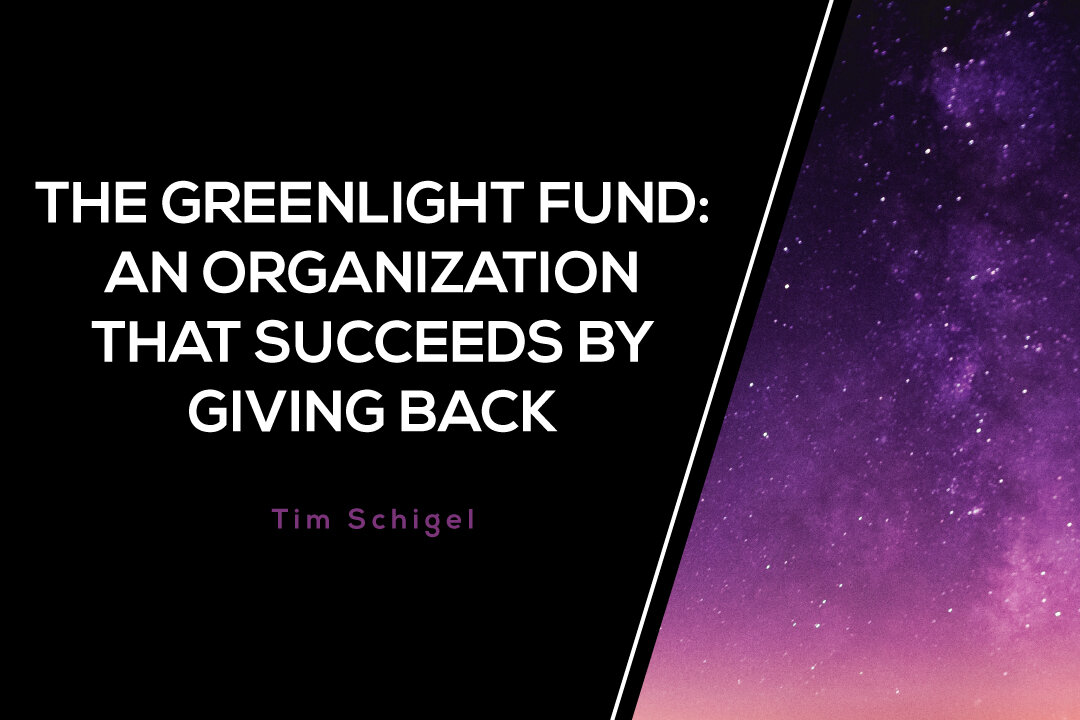In this week’s episode of Fast Frontiers, I spoke to John Simon, the Managing Director at Sigma Prime Ventures and the co-founder of the GreenLight Fund. John is an active entrepreneur, creator, and investor in both the for-profit and non-profit sectors. He is focused on software-based businesses and disruptive technology businesses, often getting involved in companies at their formation or earliest stages. I have a lot of respect for John, and I admire the model he has built for the GreenLight Fund—a very data-driven, effective, and philanthropic one.
So today we’re going to tell you about the GreenLight Fund and their unique business model. It’s a model that allows them to grow while giving back to the community, which is something that we at Refinery strongly believe in. A few months ago, I wrote about how gratitude is the secret ingredient that helps entrepreneurs and CEOs get through the numerous peaks and valleys they will inevitably face in their journeys toward success and beyond, and that a “giving back without expectations of receiving anything in return” mentality inevitably yields dramatic returns.
The GreenLight Fund helps transform the lives of children, youth, and families in high-poverty urban areas by creating local infrastructure and a consistent annual process to:
● Identify critical needs.
● Import innovative, entrepreneurial programs that can have a significant, measurable impact.
● Galvanize local support to help programs reach and sustain impact in the new city.
They are a non-profit organization but act a bit like a venture capital firm. They back social entrepreneurs and help them replicate and expand their community-focused organizations across the country.
GreenLight started in Boston in 2004. Since then, they have added nine other locations: Cincinnati, Kansas City, Philadelphia, the San Francisco Bay area, Charlotte, Detroit, Atlanta, the Twin Cities (Minneapolis and St. Paul), and Baltimore.
It’s usually difficult for non-profits to expand to new cities because it can be costly given that they run on local funds. However, GreenLight has found a way to help proven non-profits spread to new cities. They developed the GreenLight Method, a five-part, community-driven process implemented annually in each city that GreenLight is in. It allows GreenLight to focus their investments on the things that will make the most impact.
The Greenlight Method
1. Discover – Through engagement across all sectors of the community, including residents with lived experience, the local site team and the Selection Advisory Council (SAC) examine potential issue areas driven by racial and economic disparities in the region and elevate community needs not yet being adequately addressed where proven approaches could make a significant impact.
2. Scout – The team searches the country and deeply vets results-based, innovative programs best suited to tackle the identified unmet needs locally.
3. Select – In partnership with the SAC, a proven program with significant, measurable results and the best local fit is selected.
4. Invest – GreenLight helps the selected organization reach and sustain impact locally with multi-year unrestricted funding, along with ongoing on-the-ground support and strategic partnership development.
5. Measure – At the outset with each portfolio organization, GreenLight identifies and documents the programmatic and financial indicators to be measured and sets annual goals for those measures.
A short interview with GreenLight team members
We also had the chance to speak to two of GreenLight’s key team members: Emily Epstein and Clare Blankemeyer.
Emily is the marketing and communications manager from the national team in Boston. She supports all the sites and leads GreenLight’s national communications, and started with GreenLight two years ago.
Clare is the executive director in Cincinnati. After serving on GreenLight’s Selection Advisory Council for four years, she joined GreenLight full-time in September, 2020. As a SAC member she was involved in their first three selection their fund one portfolio in Cincinnati. “I saw the impact it was making for families, for people who were reentering after incarceration, and for youth that were aging out of the foster care system. Those were our three specific investments here in Cincinnati and the populations we were serving. Even before that, my career has been as either a social worker or in the services and philanthropy space throughout greater Cincinnati,” she said.
RV: What makes GreenLight different?
Clare: When I think of traditional philanthropy, I think of annual fundraising, and I think of doing the same work every year that helps impact families with economic barriers. When I think about GreenLight and what makes us unique is that we’ve learned so much from venture capital and taking that fund approach and investing in creative and innovative solutions that impact families with economic barriers. It allows us to run our GreenLight selection process annually every year, based on what the community and our non-profit leaders and people experiencing poverty are telling us every year. We are making a multi-year general operating support gift of $600,000. When we think of philanthropy, a catalytic grant of that size can really help put someone into hyper-speed, into scaling and creating a readiness and runway in our local market.
Emily: The selection process that we do year after year is sort of our secret sauce, and we bring that to every city that we’re in, which is now ten cities across the country, but it’s implemented very specific to that city.
Clare: GreenLight is about programs for people experiencing poverty that can bring about greater systems change. I love the width that we are given, the breadth that we are able to cast our net for GreenLight, because it allows us to uncover areas in Cincinnati that aren’t just workforce or just housing, but it might be education or re-entry. It’s all of those barriers that are keeping people from greater economic prosperity, and it allows our community to bubble that up based on what we need.
Emily: We recognize that there are a lot of great things happening in every city that we’re in. There are non-profit organizations doing great work. What we are really looking for is the missing piece. What isn’t being addressed that, if we could find a program that was effectively addressing, would make a big difference.
RV: Are there repeatable programs that you try even though the cities are different. For example, do you take a program that worked really well in Boston and see if it could work somewhere else or, are they more individualized to the city’s needs?
Clare: Definitely individualized to the city’s needs. We first do our landscape analysis and our needs assessments in our local market, and then we scout the nation for what the best social impact programs are that we can help fund to scale. We’re looking for the folks who have scaled outside of the mothership once already, so we’re not that early seed funding to scale for the first time. We want to see that it’s proven in multiple markets and then have pretty solid confidence.
RV: How can people from outside, like “regular Joes,” participate in GreenLight, or how can they contribute?
Clare: We have investors of all levels. We ask people to consider a multi-year contribution because we do run on a fund model, but most of our engagement comes through our Selection Advisory Council—our local community leaders and people with lived experience—who are helping us make the right selections for our city.
Emily: The other way that we get people involved is with our portfolio organizations themselves. For example, we brought a workforce development innovation called Per Scholas to Boston, and they have volunteers who work with their participants on things like resume development; other volunteers have helped by holding a book drive to support ParentChild+, a program we brought to Charlotte. It depends on the portfolio organization , but there are generally hands-on volunteer opportunities as well as partnership opportunities.
RV: Is there anything else we should know about the GreenLight Fund?
Claire: For the organizations that we invest in, we don’t write a check and walk away… I’m constantly brokering partnerships and relationships to help make sure that the organizations we bring here thrive well beyond our investments of helping them scale financially. (We provide a) community and connection aspect. We’re not just a funder; we go beyond that.
The GreenLight Fund can be a tool in a city’s toolbox to bring about change for community members, driven by community members.
Why we work with the GreenLight Fund
To conclude, I find GreenLight Fund very useful for communities because of their unique approach to using portfolio organizations. Their portfolio organizations include Food Connect, Friends of the Children, Raising a Reader Massachusetts, and 30 other organizations that solve societal issues.
I like that their programs are data-driven and measurable. GreenLight regularly measures the results of portfolio organizations against targeted goals. These 33 organizations have reached more than 325,000 children and families with their innovative, replicable, and effective programs in GreenLight cities in 2020 alone. To date, GreenLight has invested more than $24 million in these organizations and leveraged an additional $132 million in other contributions.
Most of all, we support GreenLight because it’s all about helping people who are experiencing poverty, and all the situations and circumstances that lead to poverty. We believe it’s never too early to start giving back to the community. Helping others should be just like any other daily habit. Think about what it means for your company or startup to give back to your community. For us, our office is in the inner city of Cincinnati; it’s where we work, where we eat, where we hang out—why wouldn’t we want to be contributing to help the residents of that area in whatever ways they need?
So, going back to what I said initially, and in my previous article, by giving to those who are needy, or less fortunate, you will be helping others and it will help you feel more grateful for what you have. Give back, and you’ll meet amazing people and foster kindness and goodwill within your industry and community.



